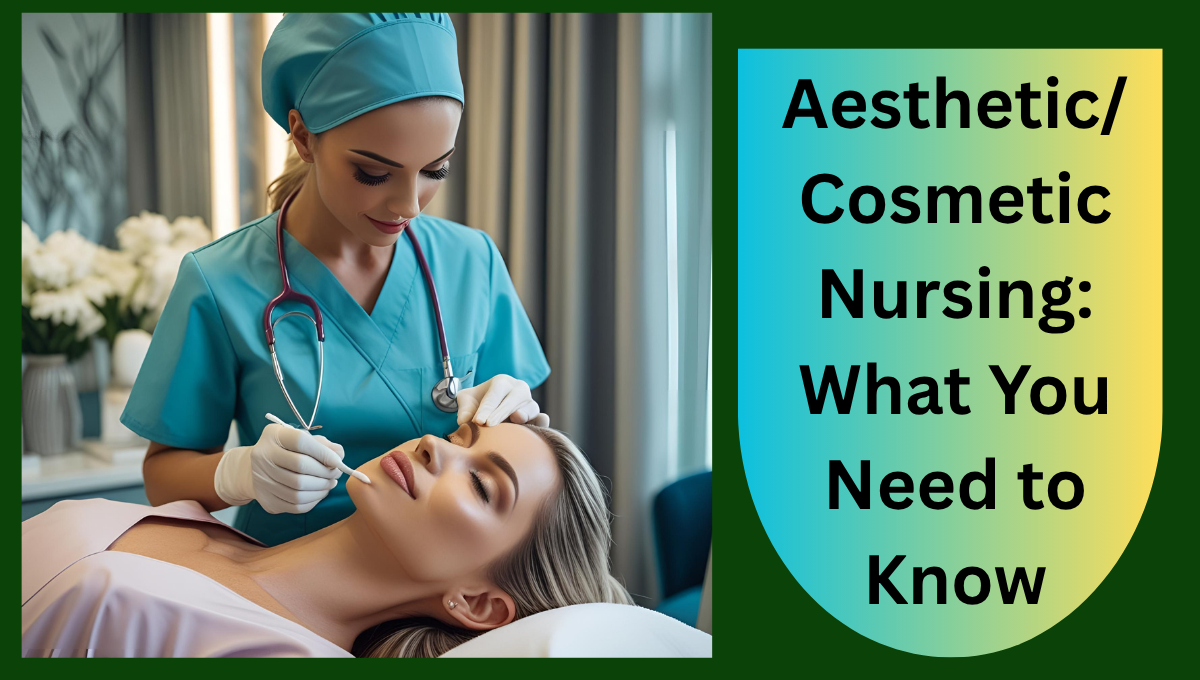Aesthetic/Cosmetic Nursing: What You Need to Know
What is aesthetic or cosmetic nursing?
Aesthetic nursing, or cosmetic nursing, is a specialist nursing discipline that concentrates on non-surgical cosmetic interventions to improve a patient’s look. These operations are conducted in medical spas, dermatological clinics, plastic surgery facilities, and other outpatient environments. Aesthetic nurses collaborate with plastic surgeons, dermatologists, and other cosmetic specialists to provide safe and effective care for patients pursuing aesthetic enhancements.
Aesthetic nurses are registered nurses (RNs) or nurse practitioners (NPs) who have specialized training in cosmetic operations. Their duties encompass the administration of Botox and dermal fillers, execution of laser treatments and chemical peels, and support in pre- and post-operative care for cosmetic procedures.

Academic Qualifications and Certification
To qualify as an aesthetic nurse, one must initially fulfill the essential requirements:
Obtain a Nursing Degree: An Associate Degree in Nursing (ADN) or a Bachelor of Science in Nursing (BSN) is necessary.
Passing the NCLEX-RN: Successfully passing the NCLEX-RN examination enables the nurse to get licensure.
Acquire Clinical Experience: A minimum of 2 years of experience in fields such as dermatology, plastic surgery, or intensive care unit (ICU) is advised.
Obtain Aesthetic certificates: Specialized certificates, such
Botox and Filler training,
Laser Safety Officer (LSO) accreditation, or
Courses from the American Association of Aesthetic Medicine and Surgery (AAAMS) are crucial for establishing credibility and enhancing skills.
Principal Obligations and Responsibilities
Aesthetic nurses are educated in a range of less invasive cosmetic techniques. Here is an overview of their fundamental responsibilities:
Injectables: Administering Botox, Dysport, and dermal fillers to diminish wrinkles and enhance facial volume.
Laser Procedures: Executing treatments including laser hair removal, skin resurfacing, and tattoo removal.
Skin Care Treatments: Performing chemical peels, microneedling, and microdermabrasion and overseeing post-treatment skin care protocols.
Consultation and Assessment: Analyzing patients’ medical histories, examining face anatomy, and suggesting the most appropriate therapies.
Patient Education: Delivering comprehensive information regarding treatment alternatives, anticipated outcomes, post-treatment care, and associated dangers.
Post-Procedure Monitoring: Facilitating secure recuperation, promptly identifying undesirable effects, and providing patient support via follow-up care.
The High Demand for Aesthetic Nursing
The global desire for non-invasive cosmetic operations has surged. The American Society of Plastic Surgeons reports that more than 18 million minimally invasive operations were conducted in the U.S. in the previous year.
Aesthetic nursing is appealing because of
Aesthetic nurses have annual salaries ranging from $70,000 to $120,000, contingent upon experience, certifications, and geographic area.
Flexible Work Hours: Predominantly employed in outpatient clinics with standard working hours, in contrast to hospital-based nursing.
Patient Satisfaction: In contrast to numerous other nursing professions, aesthetic nursing frequently produces rapid outcomes, enhancing patient morale and self-assurance.
Entrepreneurial Prospects: Numerous cosmetic nurses establish their own medspas or independent injectable clinics.
Fundamental Competencies for Cosmetic Nurses
Aesthetic nurses must exhibit a distinctive combination of medical expertise and artistic skill to excel in this sector.
Appreciation for Aesthetics: Comprehending facial symmetry, proportion, and beauty standards is essential.
Manual Dexterity: Proficient hands are essential for accurate injection methods and the manipulation of sensitive instruments.
Effective Communication: Articulating intricate procedures in accessible language and overseeing patient expectations is essential.
Emotional Intelligence: Numerous patients are emotionally invested in the outcome, so sensitivity and empathy are vital.
Continuous Education: The cosmetic sector undergoes rapid evolution. Staying abreast of emerging technology and methodologies is essential.
Standard Procedures Conducted by Aesthetic Nurses
Here is a comprehensive summary of prevalent therapies:
Botulinum Toxin Injections
Utilized for the treatment of dynamic wrinkles such as crow’s feet, forehead lines, and frown lines. Botox temporarily immobilizes specific muscles to achieve a smoother aesthetic.
Cutaneous Fillers
Fillers such as Juvederm and Restylane are utilized to replenish volume loss, enhance lip fullness, and define the contours of the cheekbones or jawline.
Laser Resurfacing
This therapy diminishes acne scars, UV damage, and fine lines by utilizing targeted laser light that stimulates skin regeneration.
Microneedling
Induced dermal damage via micro-needling stimulates collagen synthesis, enhancing skin texture and suppleness.
Platelet-Rich Plasma (PRP) Treatment
This method, known as the “Vampire Facial,” utilizes the patient’s own blood for natural skin rejuvenation.
Chemical Exfoliants
An acidic solution exfoliates the epidermal layers, aiding in the treatment of hyperpigmentation, melasma, and a lackluster skin tone.
Risks and Ethical Implications
Although the procedures are non-invasive, they are not devoid of risk. Contusions, edema, infection, and hypersensitivity reactions are potential outcomes. Ethical practice encompasses:
Consistently securing informed consent.
Performing medical evaluations to ascertain contraindications.
Preventing excessive treatment and fostering pragmatic expectations.
Upholding confidentiality and professional limits.

In which settings do aesthetic nurses practice?
Medical Spas
Cosmetic Surgery Facilities
Dermatological Clinics
Health and Wellness Centers
Private Practices
Luxury resorts and cruise ships (some provide premium cosmetic procedures)
Strategies for Establishing a Career in Aesthetic Nursing
Commence with a Robust Foundation: Acquire experience in critical care or dermatology.
Obtain Certification: Select esteemed organizations that provide practical injector training.
Engage in industry associations, participate in conferences, and establish connections with professionals on LinkedIn.
Remain Informed: Subscribe to cosmetic journals, participate in continuing education, and view industry webinars.
Compile a Portfolio: Maintain a collection of before-and-after photographs to demonstrate your expertise (with patient agreement).
Is Aesthetic Nursing Suitable for You?
Pose the question to yourself:
Are you passionate about beauty and wellness?
Do you possess confidence in your capacity to execute intricate procedures?
Are you prepared to dedicate time to continuous education and certification pursuits?
Do you appreciate engaging with clients and cultivating relationships?
If you responded affirmatively, aesthetic nursing may be your optimal specialty.
Final Assessment
Aesthetic nursing integrates scientific principles, artistic expression, and patient care. This area is experiencing tremendous growth due to great demand, substantial earning possibilities, and the satisfaction derived from assisting others in gaining confidence. Provided you possess the appropriate credentials, enthusiasm, and professionalism, the prospects in cosmetic nursing are boundless.

